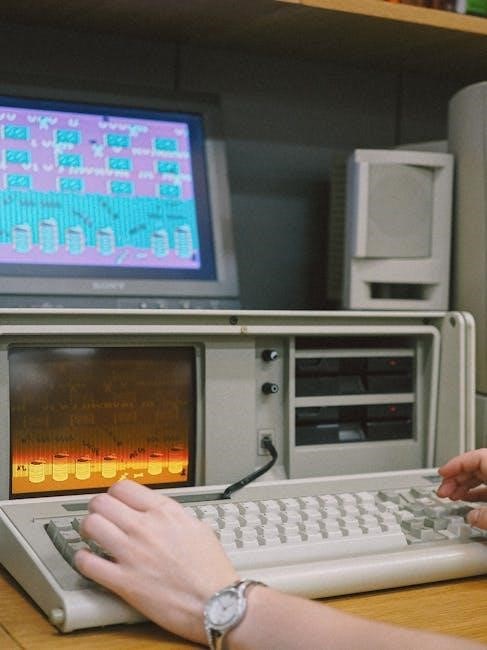Circuit breakers are essential electrical devices designed to protect power systems from overloads, short circuits, and other faults. They interrupt the current flow to prevent damage.

1.1 Definition and Purpose of Circuit Breakers
Circuit breakers are electrical devices designed to interrupt the electric current in case of faults, such as overloads or short circuits. Their primary purpose is to protect electrical systems, people, and equipment from potential damage. By automatically or manually resetting, circuit breakers ensure safety and allow the system to resume operation once the issue is resolved, ensuring reliable power distribution and preventing electrical hazards.
1.2 Importance of Circuit Breakers in Electrical Systems
Circuit breakers are crucial for ensuring safety and reliability in electrical systems. They prevent damage from overloads, short circuits, and ground faults, protecting both people and equipment. By interrupting faulty currents, they minimize risks of fire and electrical hazards, ensuring uninterrupted power supply and maintaining system integrity. Their role is vital for safeguarding modern electrical infrastructure and operations.

Classification of Circuit Breakers
Circuit breakers are classified based on voltage levels and interrupting mediums, such as air, oil, SF6, or vacuum, ensuring optimal performance across various electrical systems and applications.
2.1 Classification Based on Voltage Level
Circuit breakers are classified by voltage levels, including low, medium, and high voltage ratings. Typical ratings range from 460V to 3.3KV, with specific designs suited for distribution or transmission systems. Low-voltage breakers are used in residential and commercial settings, while medium and high-voltage types are applied in industrial and utility applications, ensuring reliable power distribution and fault protection.
2.2 Classification Based on Interrupting Medium
Circuit breakers are categorized by their interrupting medium, such as air, oil, SF6, or vacuum. Air circuit breakers use compressed air to extinguish arcs, while oil breakers utilize insulating oil. SF6 breakers leverage sulfur hexafluoride gas for high dielectric strength. Vacuum breakers rely on vacuum chambers to interrupt currents efficiently, offering reliability and reduced maintenance in high-voltage applications.
Types of Circuit Breakers Based on Extinguishing Medium
Circuit breakers are classified by their extinguishing medium: air, oil, SF6, or vacuum. Each medium provides unique arc-quenching properties, ensuring reliable operation in various voltage applications.
3.1 Air Circuit Breakers (ACB)
Air circuit breakers (ACBs) are widely used in indoor medium and low voltage switchgear. They operate by interrupting the arc in air, offering reliable performance for DC and AC circuits up to 12KV. Commonly installed on vertical panels or as draw-out types, ACBs are known for their durability and suitability in industrial and commercial applications, with ratings like 460V, 400-3500A, and interrupting capacities up to 75KA.
3.2 Oil Circuit Breakers (OCB)
Oil circuit breakers (OCBs) extinguish arcs by submerging the contacts in insulating oil, leveraging its high dielectric strength. Common in medium and high voltage systems, they are reliable for interrupting faults but require regular maintenance due to oil degradation. Despite their effectiveness, OCBs are less favored today due to environmental and safety concerns compared to SF6 or vacuum breakers.
3.3 Sulfur Hexafluoride (SF6) Circuit Breakers
Sulfur hexafluoride (SF6) circuit breakers utilize SF6 gas for arc extinction, offering high dielectric strength and excellent arc-quenching properties. Widely used in high-voltage systems, SF6 breakers provide reliable performance in interrupting large fault currents. However, SF6’s high global warming potential has led to increased focus on eco-friendly alternatives, despite their proven efficiency and durability in electrical networks.
3.4 Vacuum Circuit Breakers (VCB)
Vacuum circuit breakers (VCBs) use a vacuum to extinguish arcs, offering excellent insulation and arc-quenching capabilities. They are reliable for medium and high-voltage applications, with low maintenance needs. VCBs are known for their long service life and environmental safety, making them a preferred choice in industrial and utility power systems, with minimal risk of gas emissions or oil contamination.

Construction and Operation Principles
Circuit breakers consist of contacts, an arc chamber, and an operating mechanism. They detect faults, open contacts to interrupt current, and extinguish arcs to protect electrical systems efficiently.
4.1 Key Components of Circuit Breakers
Circuit breakers consist of contacts, an arc chamber, and an operating mechanism. The contacts carry current, while the arc chamber extinguishes arcs during interruption. The operating mechanism includes a trip unit and spring assembly to open contacts. Additional components like auxiliary contacts and terminals enhance functionality and connectivity, ensuring reliable operation and protection in electrical systems.
4.2 Working Mechanism of Circuit Breakers
Circuit breakers operate by detecting faults like overloads or short circuits. When a fault occurs, the trip unit activates, releasing a spring assembly that separates the contacts. This interruption stops the current flow. The arc chamber extinguishes the arc formed during separation, ensuring safe and reliable operation. The mechanism resets manually or automatically, restoring power once the fault is cleared.

Applications of Different Types of Circuit Breakers

Circuit breakers are used in residential, commercial, and industrial settings. Air, oil, SF6, and vacuum breakers are applied in medium and low voltage systems, while high-voltage types are used in power transmission and distribution systems.
5.1 Residential and Commercial Applications
Circuit breakers are widely used in residential and commercial settings to protect electrical systems from overloads and faults. Air circuit breakers are commonly installed in indoor switchgear for medium and low voltage applications. They are essential for ensuring safety and reliability in buildings, preventing damage from electrical surges and faults. UL Listings ensure compliance with safety standards for these applications.
5.2 Industrial and High-Voltage Applications
In industrial and high-voltage systems, circuit breakers like SF6 and vacuum types are commonly used due to their high interrupting capacity. These breakers protect against short circuits and overloads in demanding environments. Air blast and oil circuit breakers are also utilized for heavy-duty applications, ensuring reliable power distribution and minimizing downtime in industrial settings. Their robust designs handle high currents and voltages effectively.

Circuit Breaker Ratings and Specifications
Circuit breakers have rated current and voltage specifications, ensuring they handle specific loads. Typical ratings include 400-3500 A and 40-75 kA interrupting capacity for high-voltage systems.
6.1 Rated Current and Voltage
Circuit breakers are rated for specific current and voltage levels to ensure safe operation. Rated current matches the conductor’s ampacity, while voltage ratings vary from low to high applications.
6.2 Breaking Capacity and Interrupting Ratings
Circuit breakers have defined breaking capacity and interrupting ratings, indicating their ability to safely interrupt fault currents. These ratings ensure the breaker can handle maximum fault conditions without failing, protecting both the system and users.
Safety Standards and Certifications
Circuit breakers must meet strict safety standards like IEC, ANSI, and UL certifications to ensure reliable performance and protection for people and equipment.
7.1 IEC and ANSI Standards for Circuit Breakers
IEC and ANSI standards define ratings and testing requirements for circuit breakers. IEC focuses on international compliance, while ANSI ensures devices meet North American safety and performance benchmarks. These standards cover interrupting capacity, voltage levels, and operational reliability, ensuring circuit breakers provide consistent protection across global electrical systems.
7.2 UL Listings and Compliance
UL (Underwriters Laboratories) listings ensure circuit breakers meet strict safety standards. Compliance involves rigorous testing for performance and reliability. UL certification guarantees devices can safely handle overloads and short circuits, protecting users and property. It also verifies interchangeability of trip units, ensuring proper installation and functionality across various electrical systems.
Maintenance and Testing of Circuit Breakers
Regular maintenance and testing ensure circuit breakers function reliably. This includes cleaning contacts, inspecting for wear, and verifying proper operation to maintain electrical system safety and performance.
8.1 Routine Maintenance Procedures
Routine maintenance for circuit breakers includes inspections of contacts, cleaning to remove dust and debris, and testing to ensure proper operation. Regularly checking the trip settings and lubricating moving parts is crucial. Additionally, verifying the rated current and voltage ensures the breaker operates safely within its design limits, preventing potential electrical hazards.
8.2 Testing Methods for Circuit Breaker Performance
Testing methods for circuit breakers include dielectric tests to verify insulation integrity, contact resistance tests to ensure low voltage drops, and insulation resistance tests to check for moisture or contamination. Additionally, short-circuit tests assess the breaker’s ability to interrupt high fault currents safely. These tests ensure reliable performance and compliance with safety standards, maintaining system integrity and operational efficiency.
Advancements in Circuit Breaker Technology
Modern circuit breakers now feature smart technologies and IoT integration, enabling real-time monitoring and remote control. Eco-friendly designs using sustainable materials are also gaining prominence globally.
9.1 Smart Circuit Breakers and IoT Integration
Smart circuit breakers integrate IoT technology for real-time monitoring and remote control, enabling predictive maintenance and energy optimization. They provide instant alerts for overloads or faults, enhancing safety and reducing downtime. IoT-connected breakers optimize energy consumption and operational costs, making them ideal for modern smart grids and industrial applications.
9.2 Eco-Friendly and High-Efficiency Designs
Eco-friendly circuit breakers use sustainable materials like recycled components and biodegradable plastics, reducing environmental impact. High-efficiency designs minimize power consumption and energy loss, ensuring optimal performance while lowering operational costs. These advancements align with global sustainability goals, offering reliable protection for electrical systems while promoting greener technologies.
Circuit breakers are vital for electrical safety, offering protection against faults and overloads. Their evolution ensures efficiency, reliability, and sustainability, shaping the future of electrical systems.
10.1 Summary of Key Points
Circuit breakers are essential for protecting electrical systems from overloads, short circuits, and faults. They are classified by voltage, interrupting medium, and application, ensuring reliability and safety. Key types include air, oil, SF6, and vacuum circuit breakers, each offering unique advantages. Proper ratings, maintenance, and adherence to standards like UL and IEC are critical for optimal performance. Regular testing ensures functionality, while advancements like smart and eco-friendly designs shape their future.
10.2 Future Trends in Circuit Breaker Development
Future trends include smart circuit breakers with IoT integration for remote monitoring and real-time data analysis. Eco-friendly designs, such as SF6-free alternatives, are gaining traction. Advancements in high-voltage DC circuit breakers and solid-state technologies promise improved reliability. Enhanced safety features and energy efficiency will drive innovation, ensuring circuit breakers meet growing electrical demands while minimizing environmental impact.



0 Comments